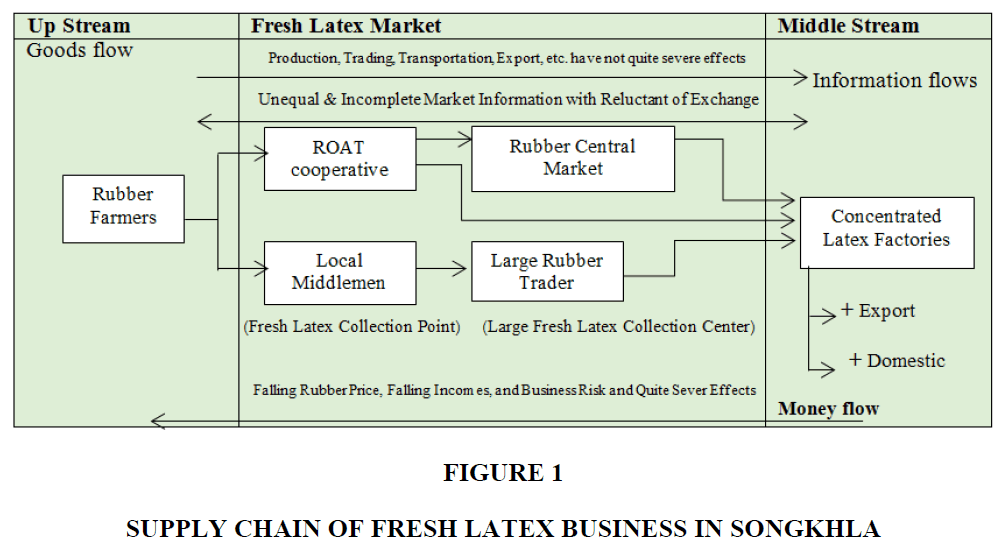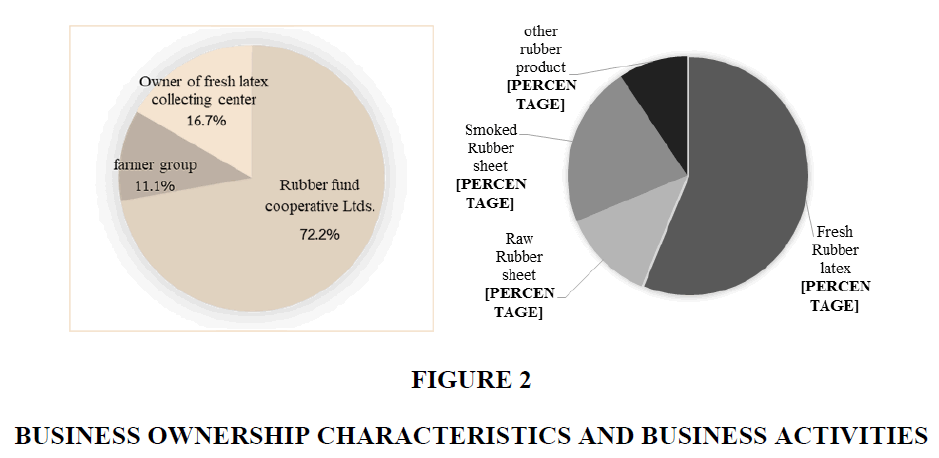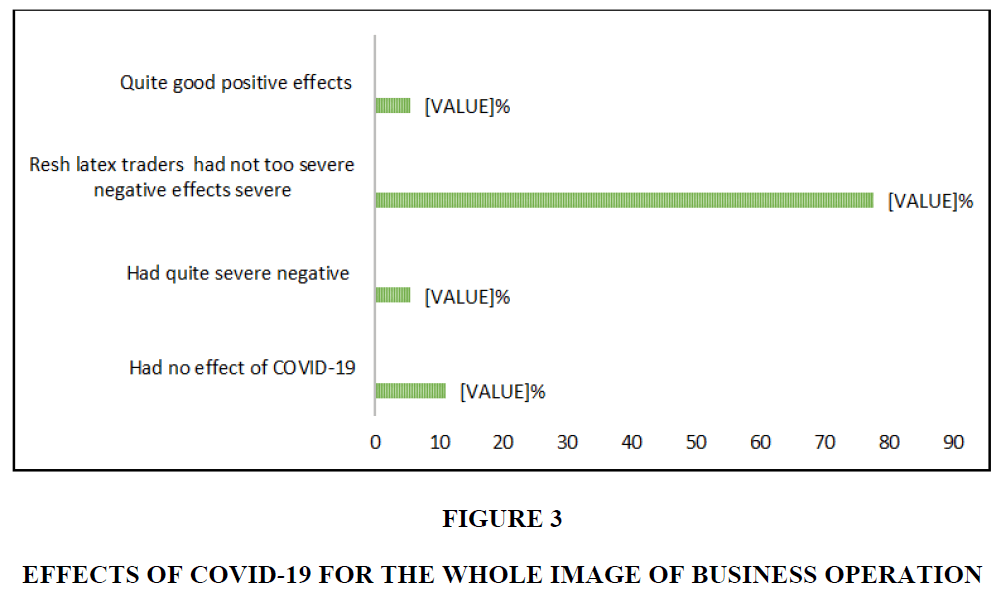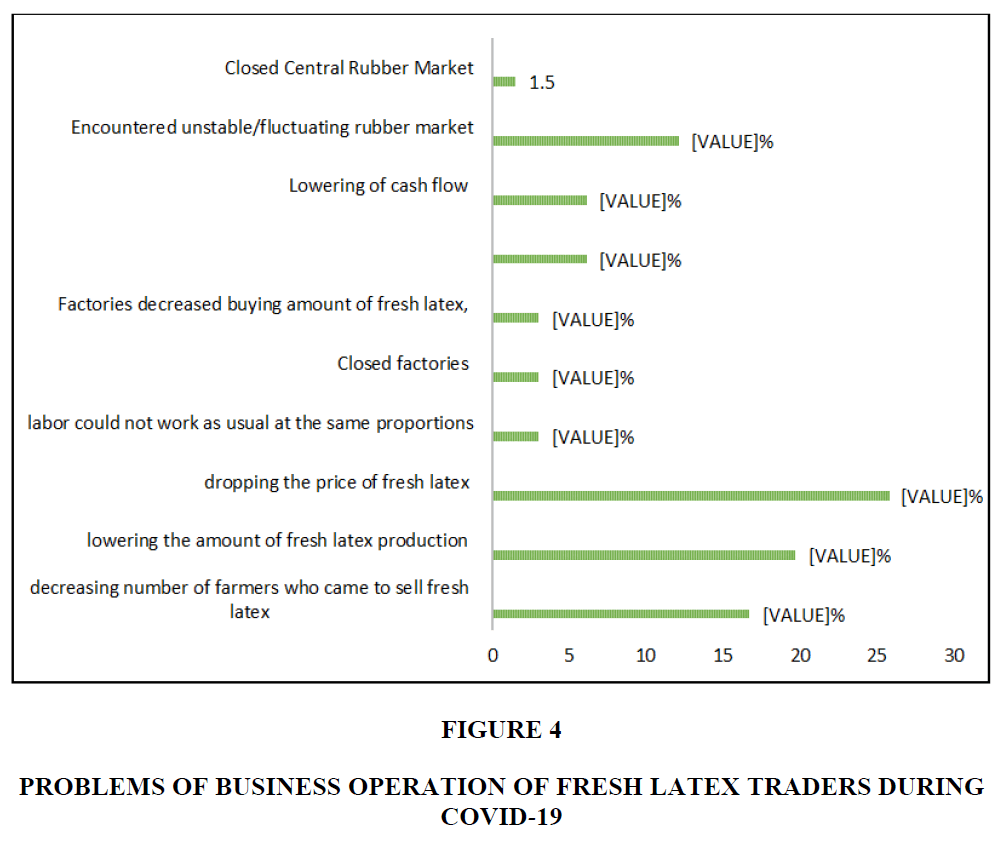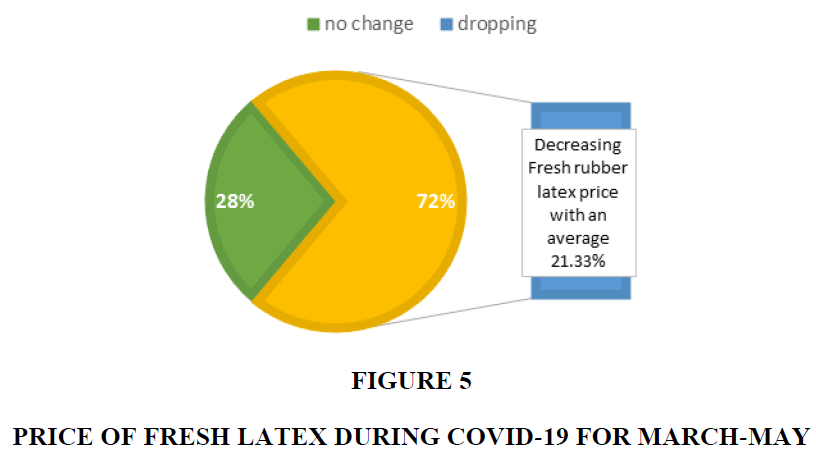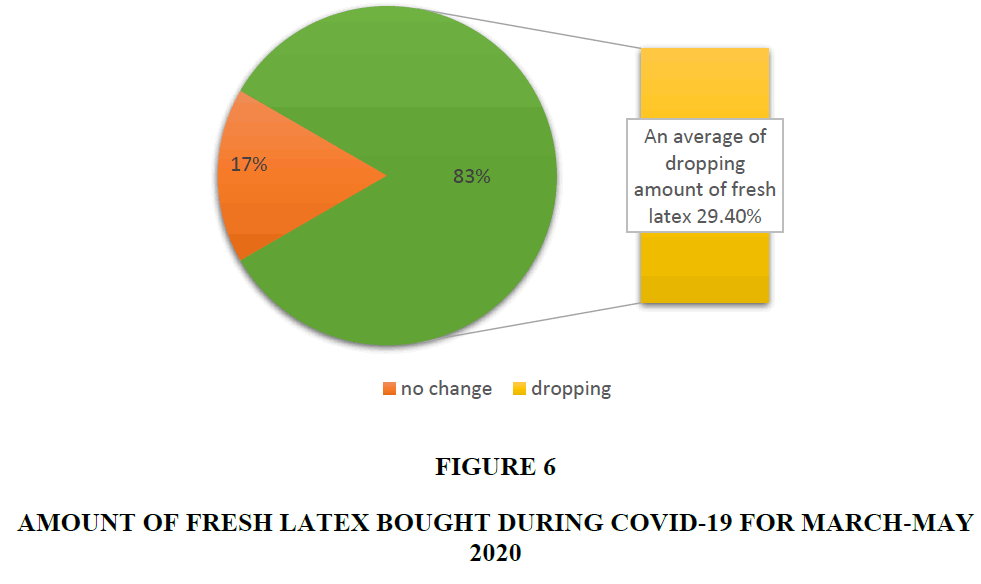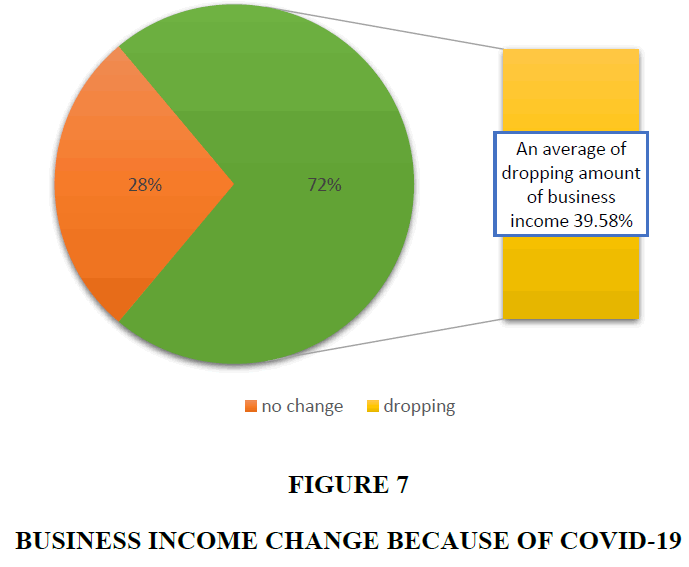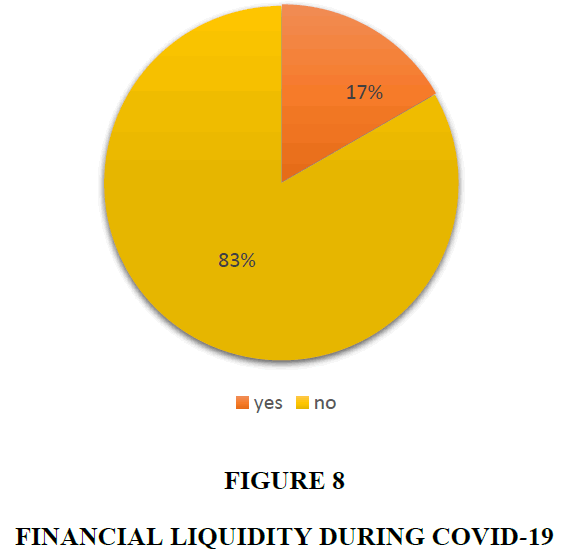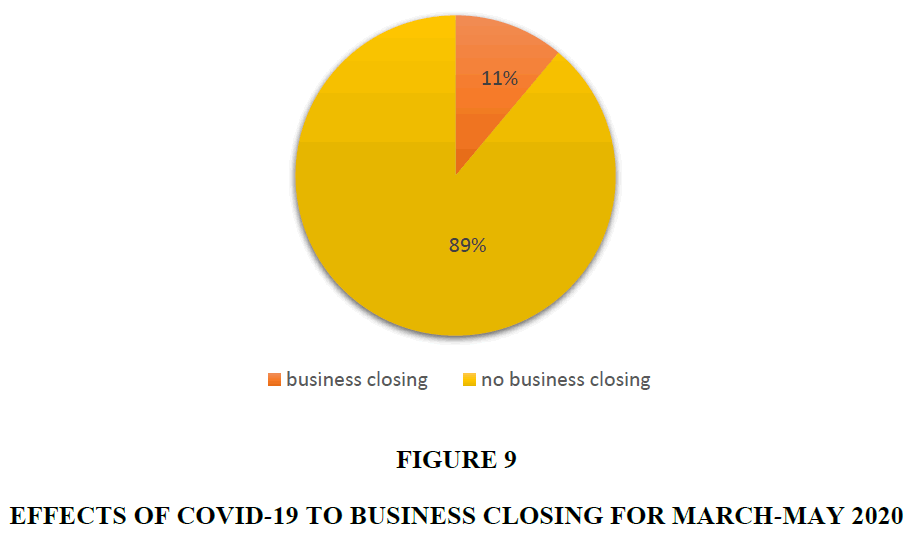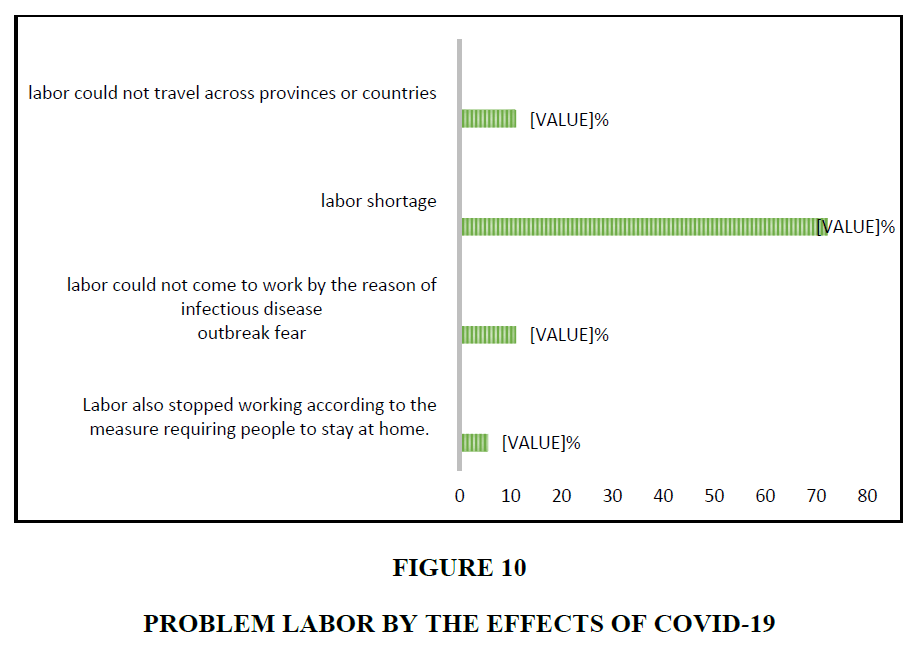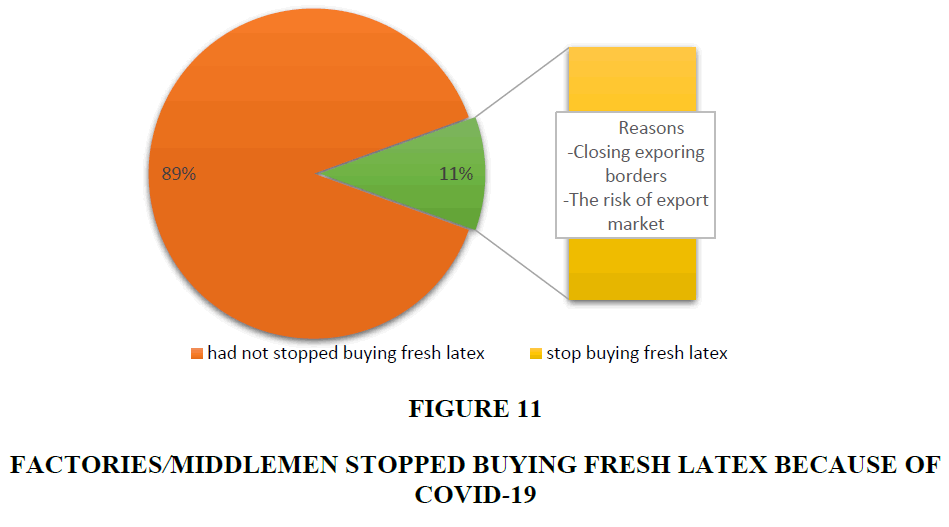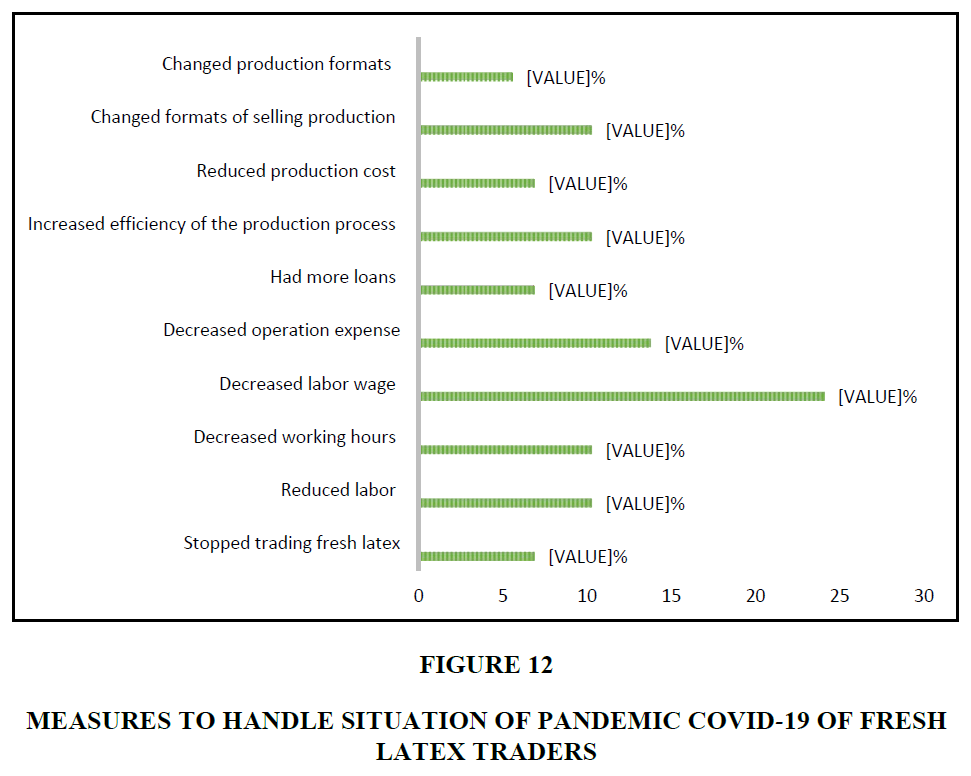Research Article: 2022 Vol: 25 Issue: 3S
Pre and post Covid-19 scenario of Thai fresh latex traders
Chaiya kongmanee, Prince of Songkla University (PSU)
Ferdoushi Ahmed, Prince of Songkla University (PSU)
Citation Information: kongmanee, C., & Ahmed, F. (2022). Pre and post Covid-19 scenario of Thai fresh latex traders. Journal of Management Information and Decision Sciences, 25(S3), 1-15.
Abstract
The effects of the Covid-19 pandemic and its impact on business activity are still uncertain and difficult to estimate. The changing and unpredictable of events forces companies to have a structured response that allows them to face any scenario. The study aims to examine the current situations, problems, and possible solutions of Thai Fresh Latex Traders socio-economic characteristics. Total 18 entities related to fresh latex traders was surveyed through a standardized questionnaire who are involved in Thai fresh latex trading from Songkhla province. The study found that approximately 80% of fresh latex traders had a negative effect but were not quite severe because less price of fresh latex and supply availability from the fresh latex farmers. In the pandemic, 11% fresh latex traders had to stop business meanwhile 89% were still continues their business. However, during this Covid-19 pandemic, the overall income of fresh latex traders is lower than the previous year specially 30% compared to the period in 2019. Whatsoever, the fresh latex traders significantly managed their business by prompt and productive actions.
Keywords
Post and Pre Covid; Rubber traders; Lockdown.
Introduction
Pandemics are the major national risk management frameworks in many countries (Chen et al., 2021; Studzinski & Pasteur, 2020) such as pandemic influenza tops the UK National Risk Register's natural hazard matrix and emerging infectious diseases are flagged as being of great concern. Viewed as a medical problem, each outbreak of a potentially dangerous infection prompts authorities to ask a rational set of questions and dust off the menu of response options that can be gradually implemented as needed. However, the reality is generally more disturbing, as national governments and supranational agencies balance health security and economic and social imperatives with the support of imperfect and evolving intelligence. It is a governance challenge that can have long-term consequences for communities and businesses (Brammer & Clark, 2020; Brammer et al., 2020). In addition to this, they must also adapt to human behaviour. The Covid-19 coronavirus disease is no exception. The Covid-19 disease, an epidemic that could turn into a global pandemic. The rubber products market consists of trade and sales of rubber products by entities that produce tires and re-treading, rubber hoses and belting, rubber sealants and all other rubber products which have domestic and industrial applications (Czainska et al., 2021). Asia Pacific was the largest region in the global rubber products market, accounting for 48% of the market in 2020 (Ferrantino et al., 2020). North America was the second largest region accounting for 20% of the global rubber products market (Widyastutik, 2020; Fimrite & McAfee, 2021). Africa was the smallest region in the global rubber products market. The outbreak of Coronavirus disease has acted as a massive restraint on the rubber products manufacturing market in 2020 as supply chains were disrupted due to trade restrictions and consumption declined due to lockdowns imposed by governments globally. Covid-19 is an infectious disease with flu-like symptoms including fever, cough, and difficulty in breathing. The virus was first identified in 2019 in Wuhan, Hubei province of the People’s Republic of China and spread globally including Western Europe, North America, and Asia. Steps by national governments to contain the transmission have resulted in halting of manufacturing activities and a decline in economic activity with countries entering a state of ’lock down’ and the outbreak is expected to continue to have a negative impact on businesses throughout 2020 and into 2021. However, it is expected that the rubber products manufacturing market will recover from the shock across the forecast period as it is a “black swan” event and not related to ongoing or fundamental weaknesses in the market or the global economy (Gudmundsson et al., 2021). The effects of the coronavirus pandemic and its impact on business activity are still uncertain and difficult to estimate. The changing and unpredictable of events forces companies to have a structured response that allows them to face any scenario. The supply chain of fresh latex trading in the studied locations is shown in Figure 1 below. All farmers usually produce fresh latex and sell 10% to cooperatives and 90% to sub-buyers at the local markets. These sub-buyers generally buy fresh latex at scattered locations and natural groups that included all farmer groups having fresh latex collection business. Then, all fresh latex goes to sell to the large fresh latex collection center and some would be sold by auction at the Central Rubber Market in Songkhla. All products possible resell to concentrated latex factories which transformed fresh latex into concentrated latex to export in foreign market.
With the aim of gaining competitive advantage and to remain the leader in world rubber production, further industrial research is clearly needed to support decision making capabilities which will allow effective management and enhancement of the supply chain. Therefore, this study aims to examine the current situations and problems of fresh latex traders’ socio-economic characteristics in southern Thailand alongside attempts to identify the pre and post Covid-19 scenario of Thai fresh latex traders.
Literature Review
Covid-19 has highlighted the tendency in many countries to deny or cover up red flags to avoid economic or political sanctions, but this approach can fail (Anwari et al., 2021; Barrios et al. 2021). Covid-19 has also shown how governance failures can involve inaction or overly zealous action on the part of ill-prepared authorities struggling to maintain or regain stability (Shimizu & Clark, 2015. Both ends of the spectrum undermine trust and cooperation between citizens and countries (Gellert, 2020). Centralized control measures may seem necessary to stop or slow the spread of the virus and compensate for weak individual and community resistance, but they can also cause harm (Gellert, 2020). When a strict policy response is deemed necessary, businesses will inevitably suffer with short-term effects (White, 2012) and less-expected long-term consequences such as:
• Travel restrictions and quarantines affecting hundreds of millions of people related to business and production (Ozili, 2020).
• Commodity prices have declined in response to a drop in consumption of raw materials, and producers are considering cutting production (Ezeaku et al., 2021).
• Mobility and job disruptions have led to sharp declines in consumption and squeezing multinational companies in various sectors as well.
As the Covid-19 virus rages across the world, the uncertainties in the business environment increase more and more. The economic impact that has had this pandemic has left millions in losses, creating unemployment, instability and especially uncertainty about what will happen in the future in some companies (Ashraf, 2020; Buheji et al., 2020). The coronavirus is an infectious disease that attacks people and has caused great human economic losses in the world (Kaye et al., 2020; McBride et al., 2021).
The ravages that the coronavirus has left drastic fall in sales, business closings and low productivity. The financial crisis has caused many industries to close their doors, causing strong medium and long-term economic problems due to not having a supply of money or adequate financial strategies in the execution and production in the activity during the months of the health emergency (Al-Fadly, 2020; Yamin, 2020). The 2020 financial budgets were terribly affected by this entire situation. Causing that multiple companies did not have a strategic plan to prevent losses in the most critical months of the pandemic (Koonin, 2020; Shammi et al., 2021). The processes of collection from their customers and payment to suppliers were affected as well as the production and sales of the products manufactured by the company and all this led to the economic scenario was even more regrettable.
International organizations have been motorized in a timely manner to maintain the supply of food, medicines, medical utensils and health equipment and other merchandise (Nayak et al., 2021; World Health Organization, 2020). Although the pandemic is affecting both advanced and developing countries, regions such as Southeast Asia (particularly Thailand) are at greater risk due to the fragility of their economies and their health systems. The region will be affected during this year 2021 and those to come due to the isolation, blockade and generalized closures of borders required to stop the spread of Covid-19, which is causing a serious effect due to the paralysis of economic and social activity in all Southeast Asian countries and worldwide. In the workplace, the International Labor Organization (2020) indicates that:
“The pandemic causes the loss of 5, 7% of working hours in the second quarter of this year, which equates to 14 million full-time workers. We are facing massive job destruction, and this poses a challenge of unprecedented magnitude in the labor markets of Latin America and the Caribbean. From now on we know that at the same time that the health emergency is overcome, we will have to face a true reconstruction of our labor markets” (p. 1).
In the months of March-May 2020, the commitments of companies with local communities, commercial partners, suppliers and consumers, human rights and global ecological problems were accentuated. However, the timing to return to normality is uncertain as it largely depends on the duration of the outbreak and the effectiveness of responses in public health policy. On this, the World Trade Organization (2020) is not very optimistic, considering that:
"The inevitable decline in trade and production will have painful consequences for households and companies, apart from the human suffering caused by the disease itself. To reactivate the investments that we will need, it will be essential that markets remain open and predictable, and foster a more favourable business environment in general” (p. 1).
In this regard, Anderson (2020) warned that China, the country where the first case of Covid-19 was officially registered, would face a possible economic contraction greater than that observed until April 2020 due to the decrease in labor mobility, tourism and entertainment services. Similarly, some macroeconomic proposals suggested the implementation of broad monetary and fiscal measures. In this sense, Galí (2020) who supports this perspective, argues that the measures of confinement, restriction of mobility, and closure of various economic activities, will have a direct effect on the economy through two types of channels: by disturbances in supply due to possible limitations in access to productive factors, and through disturbances in demand, mainly through forced changes in consumption habits. Gopinath (2020) identifies disruptive effects of supply and demand, suggests the implementation of economic policy measures focused on specific segments of the economy considers decreases in the interest rate, the provision of Central bank liquidity to commercial banks to help them provide financing to companies, mainly small and medium-sized companies, as well as fiscal stimuli aimed at aggregate demand.
As the pandemic spread around the world, the availability of information allowed for more precise studies of the magnitude and scope of its economic effects. Various investigations have indicated that the labor markets have had one of the greatest effects.
According to the authors, the initial contraction in spending is attributable to the direct effects of the pandemic, but not to imbalances in the labor market. On the other hand, Baker et al. (2020) analyze a database that records the financial transactions of households in this same country, their results suggest that at the beginning of the pandemic, spending on some types of commercial retail goods, credit card payments, and food; to later observe a drop in general consumer spending. Their results indicate that in a pandemic environment, consumption would respond even before other economic variables, such as employment, production and even investment.
Methodology
Both primary and secondary data has been used in this study. Secondary data contains statistical reports, research articles, and Thai latex industry official documents. Primary data was belonged to short field survey and in-depth interview to collect data the selected samples with structured-questionnaires and semi-structured-questionnaires. Descriptive statistics and prospective analysis have been applied to analyse the impact of pre and post Covid-19 scenario of fresh latex traders. Total 18 entities related to fresh latex traders was surveyed (during March 2020 - May 2020) who are involved in Thai fresh latex trading.
Results and Discussion
Covid-19 Effects to Adaptation of Fresh Latex Traders during March-May 2020
The study found that fresh latex traders for 77.7% had not too severe negative effects severe and 5.6% had quite severe negative effects (Figure 2). Most of the first three ranking effects were dropping the price of fresh latex, lowering the amount of fresh latex production, and decreasing the number of farmers who came to sell fresh latex. Fresh latex traders for 5.6% had quite good positive effects, and 11.1% had no effect of Covid-19.
For problems of business operation during COVID-19, the study found that fresh latex traders for 25.8% (Figure 3) had the problem of dropping the price of fresh latex, followed by 19.7% had the problem of lowering the amount of fresh latex production, 16.7% had the problem of decreasing number of farmers who came to sell fresh latex, 12.1% encountered unstable/fluctuating rubber market, 6.1% had problems of lowering of cash flow and more limitations of transporting fresh latex to the trading points at the same proportions. Furthermore, farmers for 3.0% had problems that factories decreased buying amount of fresh latex, closed factories, and labor could not work as usual at the same proportions; and 1.5% had problems of closed Central Rubber Market.
During Covid-19 for March-May 2020 (Figure 4), the study found that fresh latex price had dropped for 72.0% with an average of dropping the price for 21.33% compared with the same time in 2019, and 28.0% had no change of fresh latex price.
During Covid-19 for March-May 2020 (Figure 5), the study found that fresh latex bought by the business was dropping for 83.0% with an average of dropping amount of fresh latex for 29.40% compared with the same time in 2019, and 17.0.0% had no change of fresh latex bought by the business.
During pandemic Covid-19 (Figure 6), the study found that business incomes were dropping for 72.0% with an average of dropping amount of business incomes for 39.58% compared with the same time in 2019, and 28.0.0% had no change of business incomes.
During pandemic Covid-19 (Figure 7), the study found that most fresh latex traders for 83.0% had no problem of financial liquidity, and only 17.0% had a problem of financial liquidity.
For the situation of pandemic Covid-19 that gave effects to the business closing of fresh latex traders (Figure 8), the study found that 11 % had business closing while 89.0% had no business closing.
From the situation of pandemic Covid-19 that gave effects to fresh latex traders had labor problems (Figure 9), the study found that 72.2% had the highest labor problems, followed by 11.1% with labor problems that labor could not travel across provinces or countries, and labor could not come to work by the reason of infectious disease outbreak fear at the same proportions. Labor also stopped working according to the measure requiring people to stay at home.
The situation of pandemic Covid-19 gave effects to factories/middlemen to stop buying fresh latex (Figure 10) for 11.0% by the reasons of closing exporting borders with the risk of export markets as well, and 89.0% had no effect and had not stopped buying fresh latex.
Measures to Handle the COVID-19 Pandemic Situation
From the situation of pandemic Covid-19, fresh latex traders had measures to handle (Figure 11) the effects which 24.1% decreased labor wage, followed by 13.8% decreased operation expense; 10.3% changed sources of selling production, increased efficiency of the production process, decreased working hours, and reduced labor at the same proportions; 6.9% reduced production cost, had more loans, stopped trading fresh latex, and changed production formats at the same proportions; and 5.6% changed formats of selling production (Figure 12).
For this study, rubber traders mean sub trader, fresh latex trader, farmer group, and RAOT (Rubber Authority of Thailand) Cooperatives who are buying fresh latex from farmers at local markets and will sell this product to the Central Rubber Market or concentrated latex factories. The main respondents interviewed were head, committee, RAOT staff, fresh latex group, owners of fresh latex collection centers, and people at fresh latex buying points for a total of 18 respondents. The results of the interviews were the following (Table 1).
| Table 1 Effects of Covid-19 and Adaptation of Rubber Business | ||
| Items | Number (n = 18) |
Percentage |
| What level did pandemic COVID-19 situation have effects on business during March-May 2020? | ||
| - No effect | 2 | 11.1 |
| - Had quite severe negative effects | 1 | 5.6 |
| - Had not severe negative effects | 14 | 77.7 |
| - Had quite good positive effects | 1 | 5.6 |
| Measures to handle effects of COVID-19 during March-May 2020* | ||
| - Stopped buying fresh latex | 2 | 6.9 |
| - Reduced labor | 3 | 10.3 |
| - Decreased working hours | 3 | 10.3 |
| - Decreased labor wage | 7 | 24.1 |
| - Decreased operation expense (genera expense) | 4 | 13.8 |
| - Had more loans | 2 | 6.9 |
| - Increased efficiency of the production process | 3 | 10.3 |
| - Reduced production cost | 2 | 6.9 |
| - Changed sources of selling production | 3 | 10.3 |
| - Changed formats of selling production | 1 | 5.6 |
| Problems of business operation during COVID-19 for March to May 2020 | ||
| - The decreasing number of farmers who came to sell fresh latex | 11 | 16.7 |
| - Lowering the amount of fresh latex production | 13 | 19.7 |
| - Dropping price of fresh latex | 17 | 25.8 |
| - Labor could not come to work as usual | 2 | 3 |
| - Factories buying fresh latex closed | 2 | 3 |
| - Factories decreased buying amount of fresh latex | 2 | 3 |
| - Had more limitations of transporting fresh latex to the trading points | 4 | 6.1 |
| - Lowering of cash flow | 4 | 6.1 |
| - Unstable/fluctuating rubber market | 8 | 12.1 |
| - Central Rubber Market closed its operation | 1 | 1.5 |
| - Sanitation management to handle the pandemic disease | 2 | 3 |
| What percentages of increasing or decreasing the amount of buying production during March-May 2020? | ||
| - Decreasing | 15 | 83.3 |
| - No change | 3 | 16.7 |
| Buying production decreased for an average amount at (%) | 29.4 | |
| Fresh latex price during March-May 2020 | ||
| - Decreasing | 13 | 72.2 |
| - No change | 5 | 27.8 |
| Production buying price decreased for an average at (%) | 21.33 | |
| Had Business closed for buying fresh latex due to the direct effects of COVID-19 or not? | ||
| - Yes | 2 | 11.1 |
| - No | 16 | 88.9 |
| Labor problems due to the effects of COVID-19 | ||
| - Labor stopped working due to measure requiring people to stay at home | 1 | 5.6 |
| - Labor did not come to work by the reason of infectious disease outbreak fear | 2 | 11.1 |
| - Labor shortage | 13 | 72.2 |
| - Labor could not travel across provinces or countries | 2 | 11.1 |
| Had factories/middlemen stopped buying fresh latex due to the direct effects of COVID-19 or not? | ||
| - Yes, because the exporting borders were closed with the risk of export markets. | 2 | 11.1 |
| - No | 16 | 88.9 |
| The business had no problem of transporting fresh latex to the buying points | ||
| How was the change of business income? | 18 | 100 |
| - Decreasing | 13 | 72.2 |
| - No change | 5 | 27.8 |
| Business income was dropping for an average at (%) | 39.58 | |
| Did business had a problem with the cash flow? | ||
| - Yes | 3 | 16.7 |
| - No | 15 | 83.3 |
Problems, Resolution and Circumstances
For the whole image, the study found that all traders had not quite severe negative effects by the causes of the decreasing number of productions, falling price of rubber, and having market risk. Most farmers had adjusted the internal organization management and business strategies to cope with occurring effects also had quite a success to cope with the effects of Covid-19. Since the beginning of March 2020, the situation of Covid-19 had been increasing its severity before it created panic to rubber traders concerning market risk, price, and lockdown measures that might have effects on fresh latex entrepreneurs. All traders had closely followed information on Covid-19 and rubber market. However, no concrete anticipation of effects could be concluded. Most farmers had no business plan prepared to cope with these effects. The concrete effects had appeared obviously after the mid of March 2020 with finding that the amount of fresh latex was decreasing for 30-50% compared to the year 2019 by the reason that most farmers closed tapping panels because rubber trees would give low fresh latex at this period. The number of farmers who came to sell fresh latex was lower. However, local traders still had their businesses as usual. For the aforementioned reasons, most farmer groups or RAOT cooperatives had stopped buying fresh latex for April - mid-May every year. Farmers who still had rubber tapping would sell fresh latex to rubber buyers in the village as these buyers were in business as usual. The rubber price was falling lower than -30% compared with the same period of 2019. Rubber traders observed that the major causes were from the factories that could not export rubber as usual according to the demand shock when foreign rubber users stopped producing tires and lockdown measures. Trading across Thai-Malaysian borders closures and news rumor of concentrated latex companies closing during the end of March - April made some rubber traders found no places to sell fresh latex in time. Fresh latex had to stay overnights and spoiled. Some farmers needed to relocate the buying factories that caused a higher cost of production. Farmers had to adjust their strategies by setting the purchase price and closely followed the marketing news.
During mid-April - May 2020, rubber price was up from the lowest point at 35.0 baht/kg at the beginning of April 2020 and had an upward direction, consecutively. Most fresh latex traders had operated their businesses as usual. The previously closed RAOT cooperatives had (temporarily no business after members had closed tapping panels) been back to buy fresh latex as before. However, lockdown measures made alien labor go back to their countries and could not come back to Thailand. Then the line of production smoked rubber sheet had to be stopped for a while. At this moment, production was lower for 30% when compared with the previous year. Most of the rubber plantations just opened tapping rubber, and fresh latex harvested was still at a low amount. The large rubber plantations had not opened for tapping rubber yet or still stopped tapping rubber because hired alien workers could not come back to Thailand. Some rubber plantations of members or farmer groups had no tapping labor until now. All RAOT cooperatives had adjusted business plans to trading fresh latex which had such a good price direction. The prices of fresh latex and smoked rubber sheet were almost the same which meant that smoked rubber sheet production would lose money which trading fresh latex would be adjusting business plan in response to the market. Furthermore, during March-May 2020, some concentrated fresh latex companies had stopped buying fresh latex, periodically. Factories had bought fresh latex for 4-5 days/week and would stop buying for days with the notice of re-buying days later. Sub-sellers who sold fresh latex to these factories would stop buying the same days as the notice of the factories and would also inform farmers of the no-buying days of the fresh latex collection centers. Most area factories would not have the same no-buying days which let sellers be able to sell fresh latex every day at the factories, alternatively.
In June 2020, all RAOT cooperatives stopped producing smoked rubber sheets and adjusted the business plan to buy only fresh latex. Alien workers who could not go back to their countries would be let by RAOT cooperatives to help buy fresh latex and gave payment for daily expenses, a free sack of rice, and dry foods. Some RAOT cooperatives had bargained to reduce the wage of employees for 15% because incomes of RAOT cooperatives were down for 30-50% compared to the year 2019. Other effects had appeared, obviously. For example, members had low ability to pay back their loans, and some members pulled out their memberships because they needed money from their shareholding for livelihood expenses (For example, members of Ban Kao Rang RAOT Cooperative Limited pulled their memberships for 11.0%). The multiple numbers of members withdrew their savings which had a consequence to the amount of fresh latex of this RAOT Cooperative Limited that would be lower in the same direction. Several projects for the development of cooperatives had lateness. Lateness was also with the financial transactions at banks. Some sub-fresh-latex traders observed that after hired Burmese workers who had gone back to their country made some rubber plantations stopped tapping rubber or could not finish tapping rubber which caused a lower amount of fresh latex than 50%. This affected liquidity of traders as well. Meanwhile, working behaviors of rubber traders had adjusted according to suggestions of government working units by wearing masks even though those felt awkward and hot with less efficiency of working.
In view of the effects of Covid-19 to fresh latex traders, the study is concluding the major issues by followings:
All RAOT (Rubber Authority of Thailand) cooperatives had received the effects of the labor shortage problem. Pandemic Covid-19 was the cause of alien labor moving back to their countries and could not come back to work as usual which affected business operation closures of smoked rubber sheet factories until today. For solutions of this short period, all RAOT cooperatives had selected to stop producing smoked rubber sheets. For those having alien labor would adjust to let alien labor help work with trading fresh latex. However, labor wage and livelihood expenses would have to be reduced according to the efficiency of RAOT cooperatives. Sub-traders who had hired local labor had no labor shortage problem. Somehow, lowering the amount of fresh latex, some sub-trades had to reduce labor wages.
Conclusion
All fresh latex traders had less amount of fresh latex for 30-50% compared with the year 2019 from March-May 2020. Causes of this were tapping panel closure, having no hired tapping labor, and having a low number of members who came to sell fresh latex because of pulling out memberships from RAOT cooperatives. Some causes were the effects of Covid-19. However, most rubber plantations came back to open tapping panels in June 2020 which helped relieve problems in a better direction consecutively.
For the whole image, the fresh latex price was lower than 30 compared with the same period in 2019. The pandemic Covid-19 had affected obviously to the price fluctuation and marketing risk from March-April 2020. The price of fresh latex had been falling consecutively from 41.0 baht/kg to the lowest point at 35.0 baht/kg before the price was recovering up since May 2020. Meanwhile, there had been closing of buying fresh latex companies at some periods. All rubber traders had recognized the high risk of the demand shock before that they had to receive more marketing risks. Following information closely and adjusting to buying from the concentrated latex factories would be the major marketing strategy.
Most rubber traders had adjusted their business management methods by focusing on reducing expenses, reducing risk, and keeping liquidity because cooperative members had less ability to pay back the loans, pulled out cooperative membership status, withdrew savings of members from cooperatives, had less amount of fresh latex, and had lower incomes. These made all fresh latex traders had to reduce all expenses (e.g., labor wage, operation cost, transportation cost, allowance, etc.) and then focused on liquidity to move business operations forward.
Government and authorized organizations should take some key steps to handle uncertain shocks and any new pandemic occurring in the future such as developing supply chain, industrial cluster, and supporting factors; increasing market efficiency; developing a digital agriculture system at the production system level and having connection to the digital market of fresh latex.
References
Al-Fadly, A. (2020). Impact of COVID-19 on SMEs and employment. Entrepreneurship and Sustainability Issues, 8(2), 629.
Indexed at, Google Scholar, Cross Ref
Anderson, J (2020). China’s changing economic priorities and the impact of COVID 19. En Richard Baldwin y Beatrice Weder (Eds). Mitigating the COVID economic crisis: Act fast, and do whatever it takes. London: CEPR Press.
Anwari, N., Ahmed, M. T., Islam, M. R., Hadiuzzaman, M., & Amin, S. (2021). Exploring the travel behavior changes caused by the COVID-19 crisis: A case study for a developing country. Transportation Research Interdisciplinary Perspectives, 9, 100334.
Indexed at, Google Scholar, Cross Ref
Ashraf, B. N. (2020). Economic impact of government interventions during the COVID-19 pandemic: International evidence from financial markets. Journal of behavioral and experimental finance, 27, 100371.
Indexed at, Google Scholar, Cross Ref
Baker, S., Farrokhnia, R., Meyer, S., Pagel, M., & Yannelis, C. (2020). How does household spending respond to an epidemic? Consumption during the 2020 COVID 19 Pandemic. The Review of Asset Pricing Studies, 10(4), 834-862.
Indexed at, Google Scholar, Cross Ref
Barrios, J. M., Benmelech, E., Hochberg, Y. V., Sapienza, P., & Zingales, L. (2021). Civic capital and social distancing during the Covid-19 pandemic. Journal of Public Economics, 193, 104310.
Indexed at, Google Scholar, Cross Ref
Brammer, S., & Clark, T. (2020). COVID?19 and management education: Reflections on challenges, opportunities, and potential futures. British journal of Management, 31(3), 453.
Brammer, S., Branicki, L., & Linnenluecke, M. K. (2020). COVID-19, societalization, and the future of business in society. Academy of Management Perspectives, 34(4), 493-507.
Buheji, M., da Costa Cunha, K., Beka, G., Mavric, B., De Souza, Y. L., da Costa Silva, S. S., & Yein, T.C. (2020). The extent of covid-19 pandemic socio-economic impact on global poverty. a global integrative multidisciplinary review. American Journal of Economics, 10(4), 213-224.
Indexed at, Google Scholar, Cross Ref
Chen, X., Chong, W.F., Feng, R., & Zhang, L. (2021). Pandemic risk management: resources contingency planning and allocation. Insurance: Mathematics and Economics, 101, 359-383.
Indexed at, Google Scholar, Cross Ref
Czainska, K., Sus, A., & Thalassinos, E. I. (2021). Sustainable Survival: Resource Management Strategy in Micro and Small Enterprises in the Rubber Products Market in Poland during the COVID-19 Pandemic. Resources, 10(8), 85.
Indexed at, Google Scholar, Cross Ref
Ezeaku, H.C., Asongu, S.A., & Nnanna, J. (2021). Volatility of international commodity prices in times of COVID-19: Effects of oil supply and global demand shocks. The Extractive Industries and Society, 8(1), 257-270.
Indexed at, Google Scholar, Cross Ref
Ferrantino, M.J., Maliszewska, M., & Taran, S. (2020). Actual and Potential Trade Agreements in the Asia-Pacific: Estimated Effects. World Bank, Washington, DC. © World Bank.
Indexed at, Google Scholar, Cross Ref
Fimrite, D.E., & McAfee, C.D. (2021). Make rubber, sell rubber: building a sustainable industry. In Tire Waste and Recycling (pp. 145-163). Academic Press.
Galí, J (2020). Helicopter money: the time is now. En Richard Baldwin y Beatrice Weder (Editores), Mitigating the COVID economic crisis: Act fast, and do whatever it takes. London: CEPR Press.
Gellert, M.D. (2020). Ethical imperatives critical to effective disease control in the coronavirus pandemic: Recognition of global health interdependence as a driver of health and social equity. Journal of Health Ethics, 16(1), 3.
Gopinath, G. (2020). Limiting the economic fallout of the coronavirus with large-targeted policies. Mitigating the COVID economic crisis: Act fast and do whatever it takes, 41-48.
Gudmundsson, S.V., Cattaneo, M., & Redondi, R. (2021). Forecasting temporal world recovery in air transport markets in the presence of large economic shocks: The case of COVID-19. Journal of Air Transport Management, 91, 102007.
Indexed at, Google Scholar, Cross Ref
International Labor Organization (2020). The likely impact of COVID-19 on the achievement of SDG 8 – The role of Trade Unions. International Labour Organization (ILO).
Kaye, A.D., Okeagu, C.N., Pham, A.D., Silva, R.A., Hurley, J.J., Arron, B.L.,& Cornett, E M. (2020). Economic Impact of COVID-19 Pandemic on Health Care Facilities and Systems: International Perspectives. Best Practice & Research Clinical Anaesthesiology, 35(3), 293-306.
Indexed at, Google Scholar, Cross Ref
Koonin, L.M. (2020). Novel coronavirus disease (COVID-19) outbreak: Now is the time to refresh pandemic plans. Journal of Business Continuity & Emergency Planning, 13(4), 298-312.
McBride, O., Murphy, J., Shevlin, M., Gibson?Miller, J., Hartman, T. K., Hyland, P., ... & Bentall, R. P. (2021). Monitoring the psychological, social, and economic impact of the COVID?19 pandemic in the population: Context, design and conduct of the longitudinal COVID?19 psychological research consortium (C19PRC) study. International Journal of Methods in Psychiatric Research, 30(1), e1861.
Indexed at, Google Scholar, Cross Ref
Nayak, J., Mishra, M., Naik, B., Swapnarekha, H., Cengiz, K., & Shanmuganathan, V. (2021). An impact study of COVID?19 on six different industries: Automobile, energy and power, agriculture, education, travel and tourism and consumer electronics. Expert systems.
Ozili, P.K., & Arun, T. (2020). Spillover of COVID-19: impact on the Global Economy. Available at SSRN 3562570.
Indexed at, Google Scholar, Cross Ref
Shammi, M., Bodrud-Doza, M., Islam, A.R.M.T., & Rahman, M.M. (2021). Strategic assessment of COVID-19 pandemic in Bangladesh: comparative lockdown scenario analysis, public perception, and management for sustainability. Environment, Development and Sustainability, 23(4), 6148-6191.
Indexed at, Google Scholar, Cross Ref
Shimizu, M., & Clark, A.L. (2015). Interconnected risks, cascading disasters and disaster management policy: a gap analysis. GRF Davos Planet@Risk, 3(2), 260-270.
Studzinski, N.G., & Pasteur, L. (2020). Comprehensive pandemic risk management: A systems approach. Visiting International Research Fellow Policy Institute, King’s College, London.
White, W.R. (2012). Ultra easy monetary policy and the law of unintended consequences. Federal Reserve Bank of Dallas Globalization and Monetary Policy Institute Working Paper No. 126.
Widyastutik. (2020). Competitive analysis of the sumatra rubber industry in asean free market. Jurnal Manajemen & Agribisnis, 17(1), 63-73.
World Health Organization. (2020). Priority medical devices list for the COVID-19 response and associated technical specifications. COVID-19: Essential resource planning.
World Trade Organization. (2020). Trade set to plunge as COVID-19 pandemic upends global economy. World Trade Organization.
Yamin, M. (2020). Counting the cost of COVID-19. International Journal of Information Technology, 12(2), 311-317.
Indexed at, Google Scholar, Cross Ref
Received: 10-Dec-2021, Manuscript No. jmids-22-10385; Editor assigned: 14-Dec-2021, PreQC No. jmids-22-10385(PQ); Reviewed: 14-Jan-2022, QC No. jmids-22-10385; Revised: 22-Jan-2022, Manuscript No. jmids-22-10385(R); Published: 28-Jan-2022
